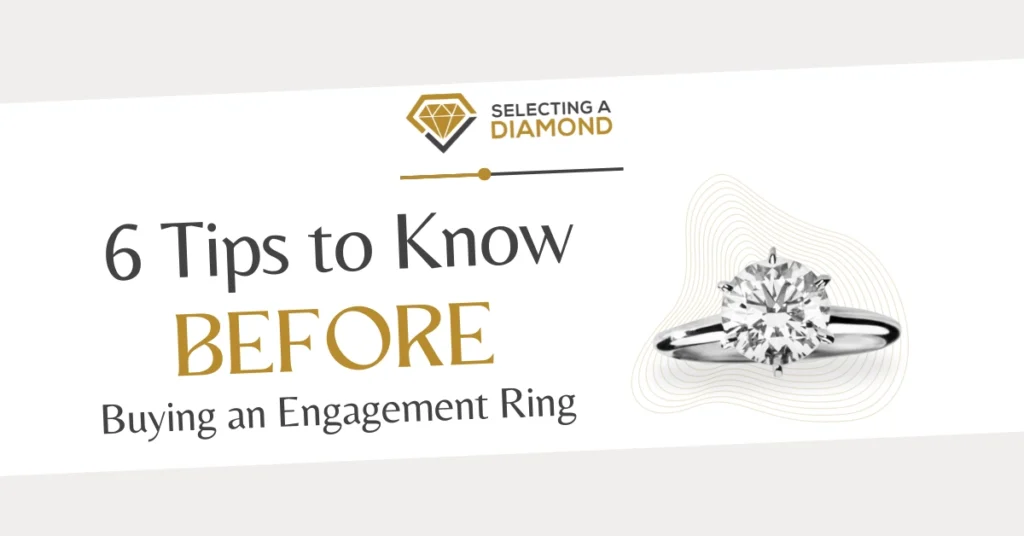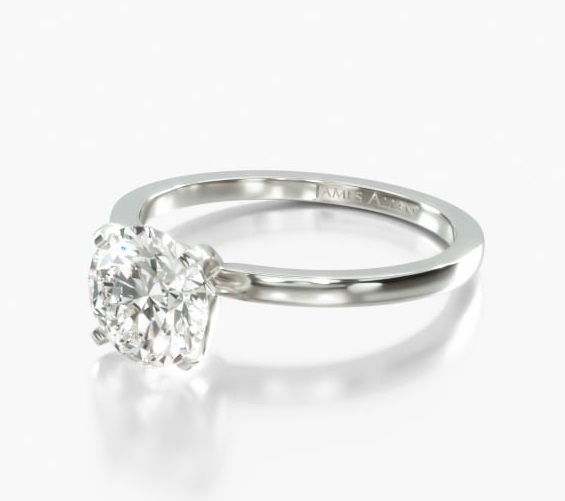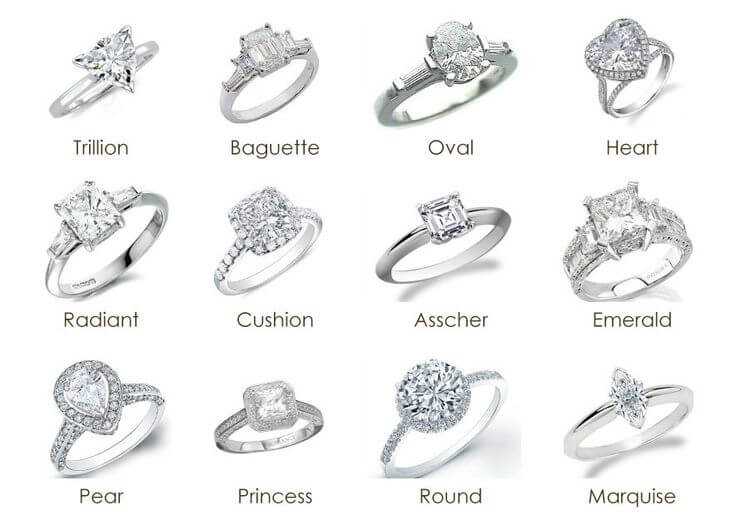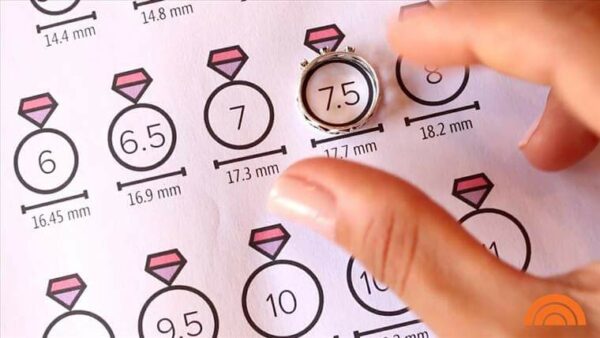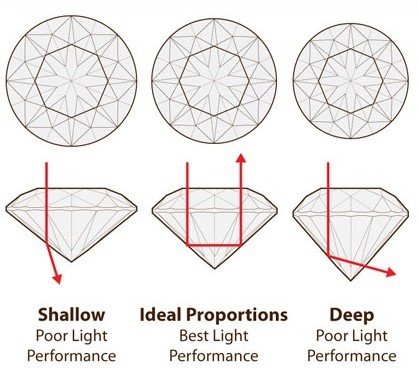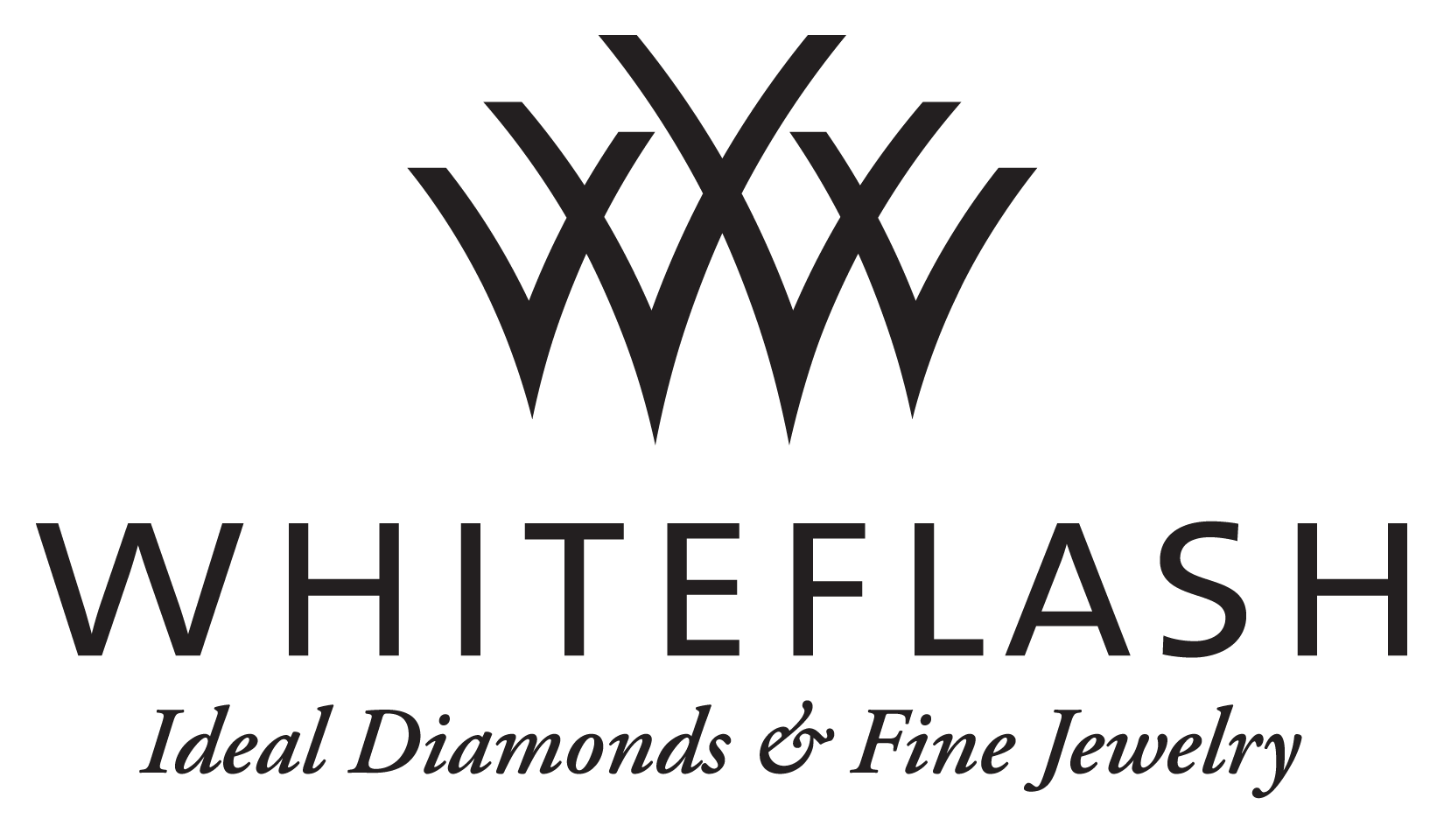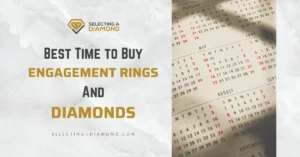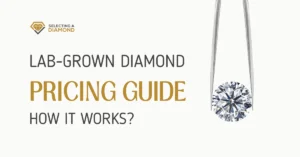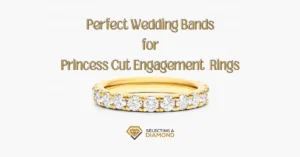We may earn a commission when you purchase through our affiliate links, at no extra cost to you. This helps support our work and allows us to continue providing unbiased, expert diamond advice.
Browsing for engagement rings online can present a dazzling array of choices. But all too often, they can exceed your budget, or you might struggle to pair the perfect setting with the best diamond to achieve your desired ring.
Many people confess there are things they wish they knew before embarking on the journey to buy an engagement ring. That’s precisely why we’ve curated this guide.
Purchasing a ring isn’t like any regular shopping experience. Not to add undue pressure, but it’s important to be well-informed before making such a significant decision. And we’re here to help with that.
So, are you ready to find an exquisite engagement ring like this one within your budget? Let’s unravel the mystery together.
Why Does Buying an Engagement Ring Seem Complicated?
In a nutshell, it’s because there are over 10 diamond shapes, a myriad of ring/setting styles, and around half a dozen common ring metal options. Mixing and matching these components can result in hundreds of options!
Factor in her personal style, ring size, the 4Cs, budget, and numerous other considerations, and you might feel a tad overwhelmed.
The silver lining? All this can be simplified once you follow our 6-step guide to finding the ultimate engagement ring.
In today’s flexible social climate, many couples discuss the bride-to-be’s preferences for a diamond engagement ring, even visiting jewelry stores or browsing online together to try on different shapes and settings.
However, some of us still cherish the delight of surprising our partner with a carefully chosen diamond. So, whether you’re making this journey together or planning a surprise, here are six straightforward steps to guide you.
Let’s break this down into 6 insightful tips and steps.
Step One: Decide Your Budget For The Whole Ring (Setting & Diamond)
Before anything else, it’s crucial to establish a budget. Even if you have some flexibility, you should still have a ballpark figure in mind (for instance, are you looking to spend $5k, $10k, or $30k?).
This doesn’t mean you need to know whether you’re willing to spend $5000 or $5500, no. Rather, you need an estimate of the amount you’re comfortable with, such as $1k-$2k, $8k-$10k, or even $15k-$20k.
Tip: For further insights, read and learn about how much to spend on a diamond engagement ring.
Once you’ve settled on a budget, you can then focus on details like size, cut, and other characteristics of engagement rings and diamonds, which are largely dependent on your price range.
Step Two: Select the Diamond Shape & Ring Setting
When it comes to selecting the diamond shape and ring setting, the options might seem endless initially.
However, it’s important to remember that not all diamond shapes and settings will suit everyone. A diamond that first catches your eye might not necessarily look best on her hand.
For instance, a round diamond might be more flattering on a small, delicate hand than a marquise cut that covers more of her finger. If the size of the diamond matters, you might want to choose a shape that offers more surface area than depth, like an emerald cut, to maximize the appearance of size.
To visualize how the diamond might look on her hand, you could use this great 3D tool at James Allen. This image also shows different types of cuts:
Step Three: Consider Her Other Jewelry
Every woman wants her diamond ring to not only stand out but also to complement her other jewelry. Does she prefer contemporary pieces, or does her taste lean more towards traditional styles?
Round diamonds are the most traditional choice, emerald cuts are viewed as very elegant, while princess, pear, and marquise cuts have a more modern appeal. It would be a good idea to ask a jeweler to distinguish between the more classic settings and the contemporary ones. If you’re feeling creative, you can design your own setting and search online for a diamond that would fit perfectly.
When selecting a setting, ask yourself: Does she usually wear silver jewelry (suggesting she might prefer a white gold or platinum setting) or does she lean towards yellow gold?
Trying on various diamonds in different settings is undoubtedly the best way to discover what looks most beautiful on her hand. But if that’s not your approach, listen for hints. Does she comment on diamonds she sees in magazines or on her friends’ engagement rings? If not, her close friends or family members might be able to provide some helpful insights (as long as they can keep a secret!).
Step Four: Know Her Ring Size
If you’re shopping alone, getting her ring size right is crucial for maintaining the element of surprise. Imagine getting down on one knee, proposing to her, and then discovering the ring doesn’t fit!
Although you can reassure her that it can be resized, and she might understand, it would be best to avoid this situation altogether. Not to mention, you can avoid the additional cost of resizing.
Here are a few ways to find out her ring size:
- Ask her family or friends: Her close friends or family members (those who can keep a secret, of course) might be able to help.
- Borrow one of her rings: If you live together, find a ring she hasn’t worn in a while and take it to a jewelry store to have the size measured.
- Make an imprint: THE BEST OPTION – Create an imprint of one of her rings in a bar of soap, and take the soap to a jeweler. They can measure the imprint and determine the size of the ring you should buy.
Want more ideas? Check out the full list of How to Find Her Ring Size
Buying from a reputable jeweler or a website that offers free ring sizing is crucial. Here’s an online ring sizing tool. For a more precise measurement, you can request a free ring sizer sent to you by mail.
Step Five: Assessing the Diamond – The 4Cs
Once you’ve decided on the diamond shape and ring setting, understanding some specifics about diamonds is essential for a smart purchase. The 4Cs – Color, Clarity, Cut, and Carat weight are crucial factors determining a diamond’s quality and worth.
The diamond’s brilliance – its sparkle – is a product of its color, clarity, and cut (note that carat is excluded here, to be elaborated later). A masterful craftsman can enhance the diamond’s fire and brilliance through expert cutting of the raw stone. The positioning and precision of each facet cut is vital.
Diamond Color
The color of diamonds is graded from Colorless to Yellow, with the former being the priciest and presumably of higher quality.
In a diamond certificate or online diamond features, you’ll see a letter notation from D for colorless down to J for the lowest graded color diamonds. Remember, this discussion only covers white diamonds and excludes fancy color diamonds.
This scale in the image below shows you different color grades for diamonds, including these fancy colors diamonds.
While most retailers or online diamond sites will try and tell you that getting as high a diamond color grading as possible is preferred for the beauty of the stone, please don’t take their word for it.
For example James Allen clearly states that “when shopping for a diamond, it is generally preferred to have the least amount of color possible.”
Later on the same page they also state that
Most people find it very difficult (if not impossible) to tell the difference from one color grade to another. The difference in price, however, can be significant.
For more insights on diamond colors, you can check our detailed diamond colors article.
Engagement Ring Diamond Clarity
Diamond clarity indicates the “cleanliness” of the diamond. Imperfections like tiny chips or ‘clouds’ are often present in diamonds and may or may not impact the diamond’s beauty.
These imperfections are either called inclusion or blemishes (depending on if they are internal, or reached the surface), inclusions has several types which differs in how much they can affect the diamond brilliance & durability.
On diamond sites like James Allen or Blue Nile, you’ll see clarity indicated by codes like FL for Flawless diamonds down to I3 for Included diamonds. These codes reflect the severity of the diamond’s flaws under 10X magnification.
As you can imagine the price of a diamond will vary depending on its clarity with Flawless diamonds costing much more than ones with lower diamond clarity (but still beautiful diamonds).
Here is a diamond clarity chart we put together with real-world examples of various diamonds. It has large images of many diamonds so you can see for yourself the difference between each diamond clarity grading.
Engagement Ring Diamond Cut
Presenting the most crucial C among all Cs – the Cut!
Given that the diamond in the engagement ring is the primary and most noticeable element, you should pay utmost attention to this aspect.
A diamond cut refers to the symmetry of the diamond parts and its ability to reflect light. The sparkle you observe when looking at a diamond is a product of its cut.
Ever wondered why some diamonds sparkle more than others (you might hear this referred to as diamond Brilliance)? It is primarily due to the diamond cut quality. The light or sparkle you perceive is the light reflection off the diamond’s table. If you desire a more technical understanding, visit this James Allen page on the diamond cut.
Did you know that a diamond lacking sparkle, appearing lackluster, is typically the result of a poor cut? Among the 4Cs, the diamond cut has the most significant impact on the diamond’s appearance to the naked eye. A downgrade from VS1 to SI1 clarity or an E to H color is barely noticeable. However, a drop from Ideal to Good cut can often be visible to the naked eye because it will lack the expected sparkle.
For more insights on diamond cut, refer to our comprehensive diamond cut guide.
Engagement Ring Diamond Carat Weight
The modern system of using carat as the measurement unit for diamond weight was standardized in 1907 at the Fourth General Conference on Weights and Measures. It was agreed at the conference that a diamond carat would equal 200 milligrams, and this has become the universally accepted diamond weight measurement.
But remember, it’s not all about the weight. Don’t always chase after diamonds with higher carat weights, because the cut matters the most. Consider this.
The diamond cut graphic (courtesy of James Allen) below illustrates that three diamonds of identical carat weight can appear vastly different in size (the visible surface area to the eye) and reflect light differently. When purchasing a diamond, strive to get the one that balances these two aspects and offers the best overall cut rather than the highest overall carat weight.
For more details on diamond carat, refer to our detailed diamond carat article.
Step Six: Where to Buy an Engagement Ring
Even though many people adhere to traditional shopping habits, such as visiting local stores, especially when purchasing precious items like engagement rings, a growing number are considering the benefits of online purchases. The concerns are valid: how can I trust a website with such a significant purchase? How can I be sure I’m getting what I paid for and not being scammed?
In response to these queries, we’ve written a guide about buying diamonds online, but to summarize, here are some key points comparing online shopping with traditional retail stores:
- Numerous reputable online platforms provide high-resolution images of the exact diamond you’re considering, enabling you to scrutinize all the diamond’s details before making a decision.
- As surprising as it may sound, several websites on the internet are extremely trustworthy for diamond purchases, even when spending hundreds of thousands of dollars! Once you’ve made your purchase, there’s no need for second thoughts. For instance, James Allen is one of these highly reputable online vendors that we consistently recommend to our readers.
- Shopping online doesn’t just offer competitive prices but also boasts a larger selection than most brick-and-mortar jewelry retailers can provide. Plus, online shopping comes without the pressure typically encountered in physical stores. There’s no rush to make an immediate decision. You can take your time, research, compare, and then buy when you’re ready and comfortable.
Summary
Buying an engagement ring can often feel overwhelming due to the numerous choices and considerations involved. This guide provides an approach to simplify the process. First, it is crucial to establish a budget that will inform the characteristics of engagement rings and diamonds you can afford. Then, you need to select a diamond shape and ring setting that suits the wearer’s style and hand shape. Remember to consider the person’s existing jewelry to ensure the engagement ring complements them. Also, knowing the ring size is essential to maintain surprise and avoid resizing costs.
Understanding the 4Cs of diamonds – Color, Clarity, Cut, and Carat weight – is crucial as they affect a diamond’s quality and price. Lastly, consider buying the ring online as it offers competitive prices, a larger selection, and a no-pressure shopping experience. Online platforms like James Allen provide high-resolution images of the diamonds, allowing you to scrutinize all the details before making a decisio
Still not sure where to buy your diamond?
We always recommend shopping diamonds online and created a Full guide to shop diamonds like a Pro.
Among online retailers, here are our favorite stores click their logo to visit store
-
James Allen:
Our favorite online store, best diamond imaging technology available today, comes with the largest collection with more than half a million loose diamonds.
-
Blue Nile:
Widest collection of loose diamonds of all sizes, great imaging technology for most of their inventory (hundreds of thousands of diamonds), great customer support.
-
Whiteflash:
Home Of A CUT ABOVE® Super Ideal Diamonds, they stand out from the crowd by offering premium diamonds cuts, tailored to those who love the details, at great prices too.

